Authentic Pakistani karahi gosht features mutton or goat cooked in a rich tomato-based curry brimming with tomatoes, ginger, garlic, and chilies. It is a traditional recipe cherished across Pakistan and India, primarily due to its popularity in dhabas and home kitchens. While some modern recipes include onion or yogurt, we stick to the basics with our take on the Pakistani classic.
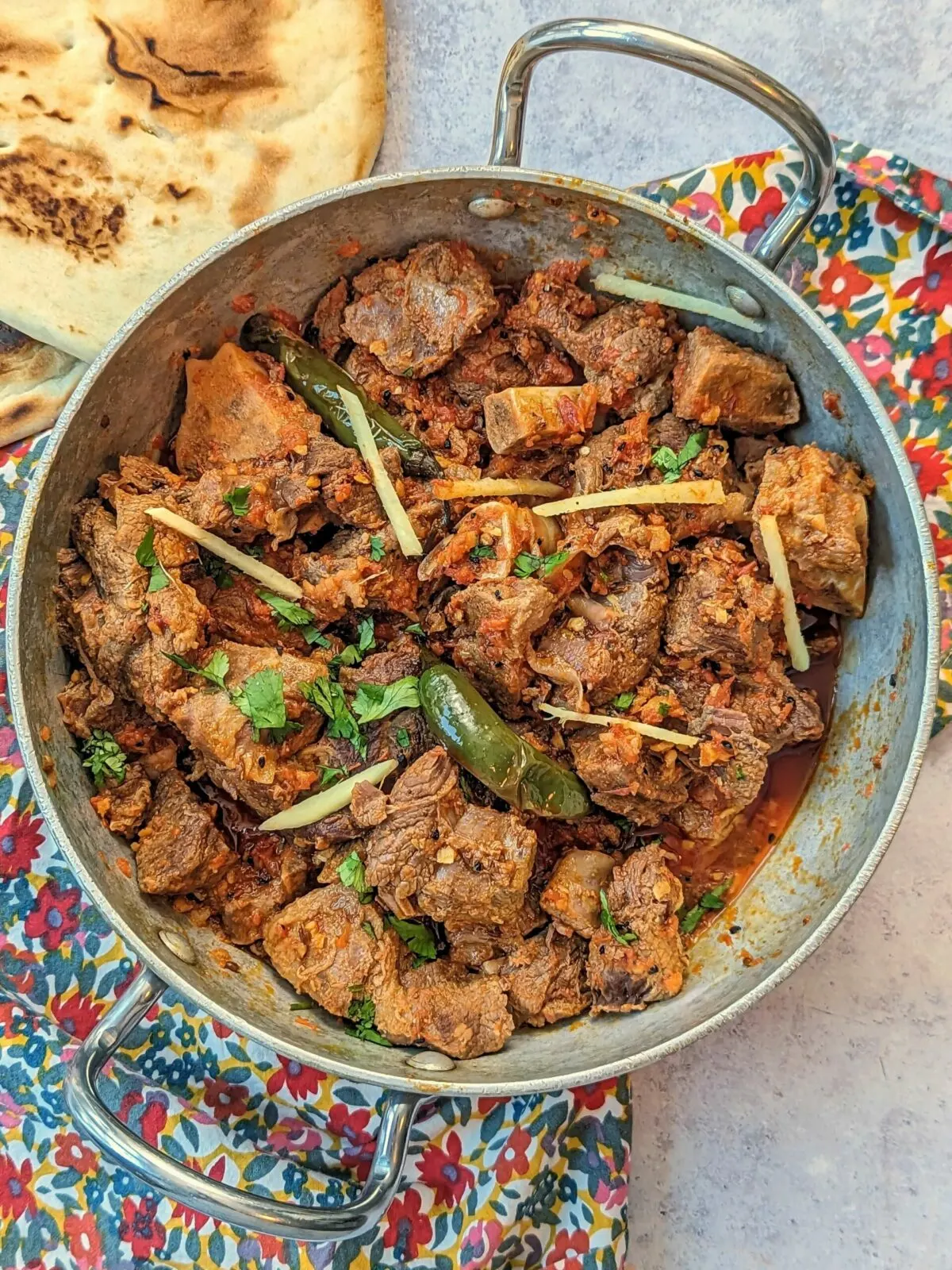
What is Karahi Gosht?
Goat karahi is one of my favorite meals to prepare for my family. The dish originates from the Khyber Pakhtunkhwa region of Pakistan; many recipes feature mutton or goat. However, you can also prepare karahis with chicken, beef, or fish! Tomatoes, garlic, ginger, and chilies deliciously flavor the dish with a rich, concentrated flavor.
Once you’ve made this recipe for goat karahi, try our restaurant-style chicken karahi!
What You Need to Make this Recipe
- Mutton or Lamb: I use bone-in goat shoulder. Cut the shoulder yourself or ask the butcher to cut it into smaller pieces. I usually purchase goat or lamb at local Indian, Arab, Mexican, or Asian market. Places like Whole Foods carry both. However, they are often more expensive.
- Ghee: Ghee develops a deep, nutty flavor for the dish; mustard oil is a great alternative.
- Cumin Seed: Toast cumin seeds in ghee to pronounce and enhance their natural flavor.
- Chilies: Green chilies add heat that doesn’t overwhelm. If you prefer a spicier curry, chop the chilies before adding them.
- Ginger: Ginger is one of my favorite ingredients in karahi! It flavors the masala and serves as a tasty garnish.
- Garlic: I suggest using four garlic cloves, but measure with your heart.
- Tomato: Fresh tomatoes are the base for authentic karahi recipes. I use Roma tomatoes since they have less moisture than other varieties. Puree the tomatoes in a food processor to reduce the cooking time (and disguise them for my husband); traditional recipes call for cut or diced tomatoes that fry in the pan. You can go this route, but it increases the cooking time.
- Spices: Salt, pepper, Kashmiri chili powder (paprika), cumin powder, coriander powder, and kalonji seeds come together to season this dish.
- Cilantro: Finish karahi with freshly chopped cilantro.
How to Make Karahi Gosht
The full recipe with measurements is in the recipe card below.
Step 1: Add lamb or mutton, water, and salt to an Instant Pot or Pressure Cooker. Cook at manual high pressure for 30 minutes if you’re at low elevation and 1 hour for those at a higher elevation.
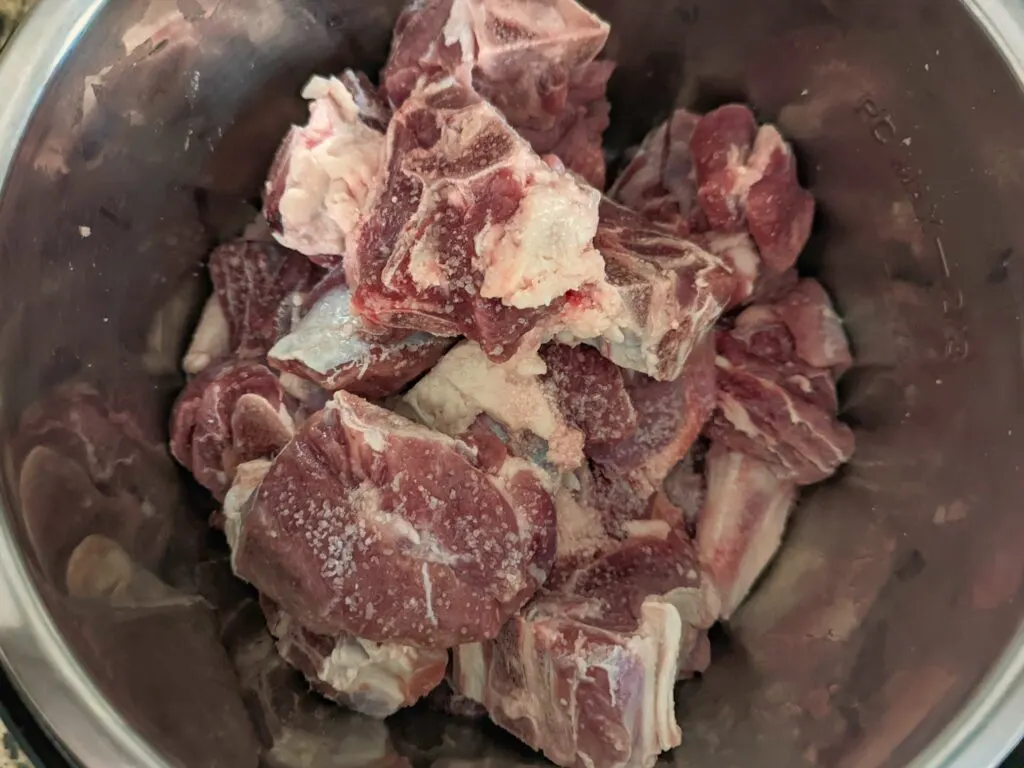
Step 2: Meanwhile, warm the ghee in a heavy-bottomed pan over medium-high heat. Then, add cumin seeds and green chilies. Cook until they sputter.
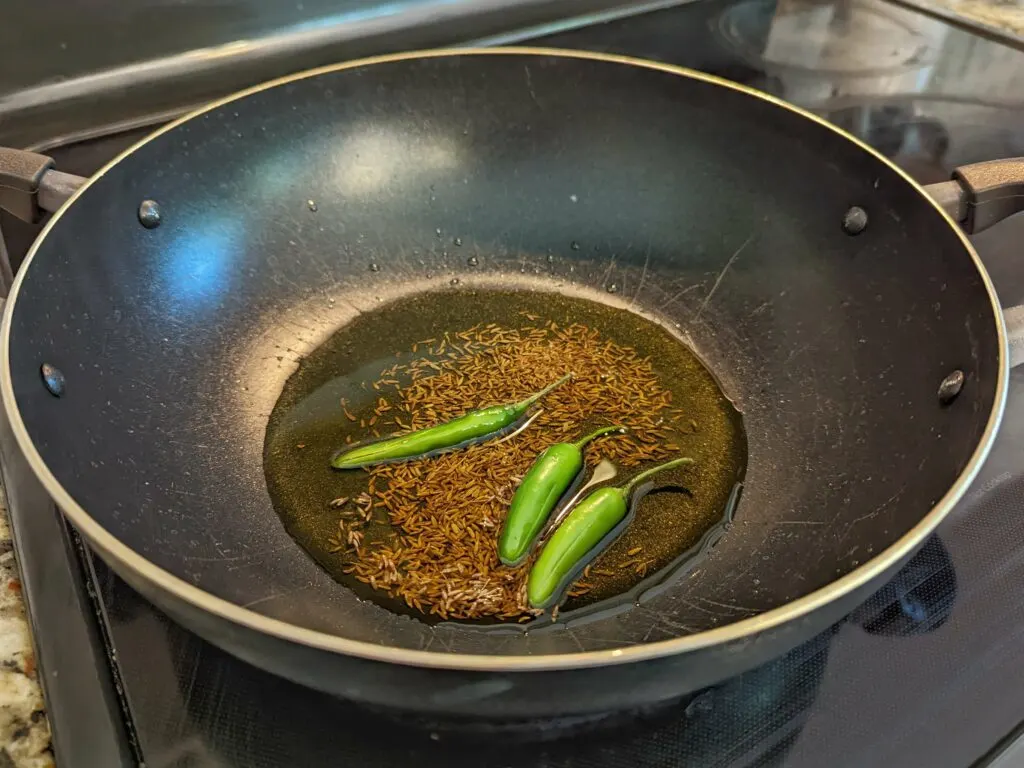
Step 3: Add ginger and garlic, and cook for another couple of minutes until the raw smell fades.
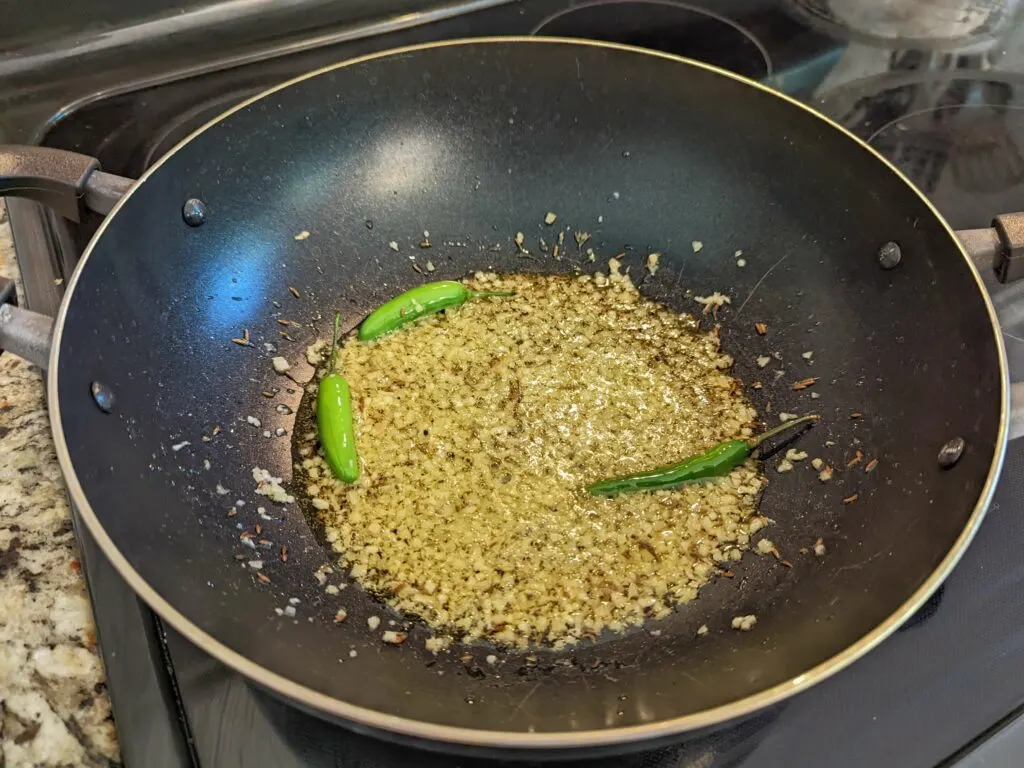
Step 4: Stir the salt, pepper, Kashmiri chili powder, cumin powder, coriander powder, kalonji seeds, and pureed tomatoes into the mixture.
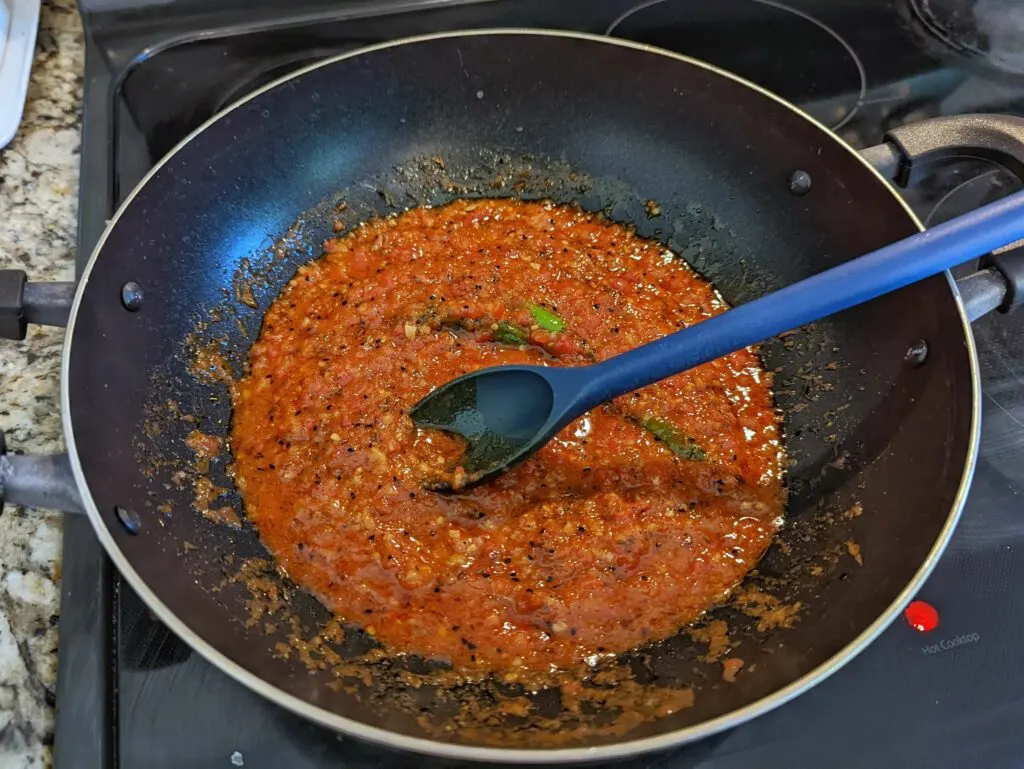
Step 5: Lower the heat, cover, and simmer for 15 minutes; stir to ensure nothing sticks to the bottom. Then, remove from heat until the goat finishes cooking.
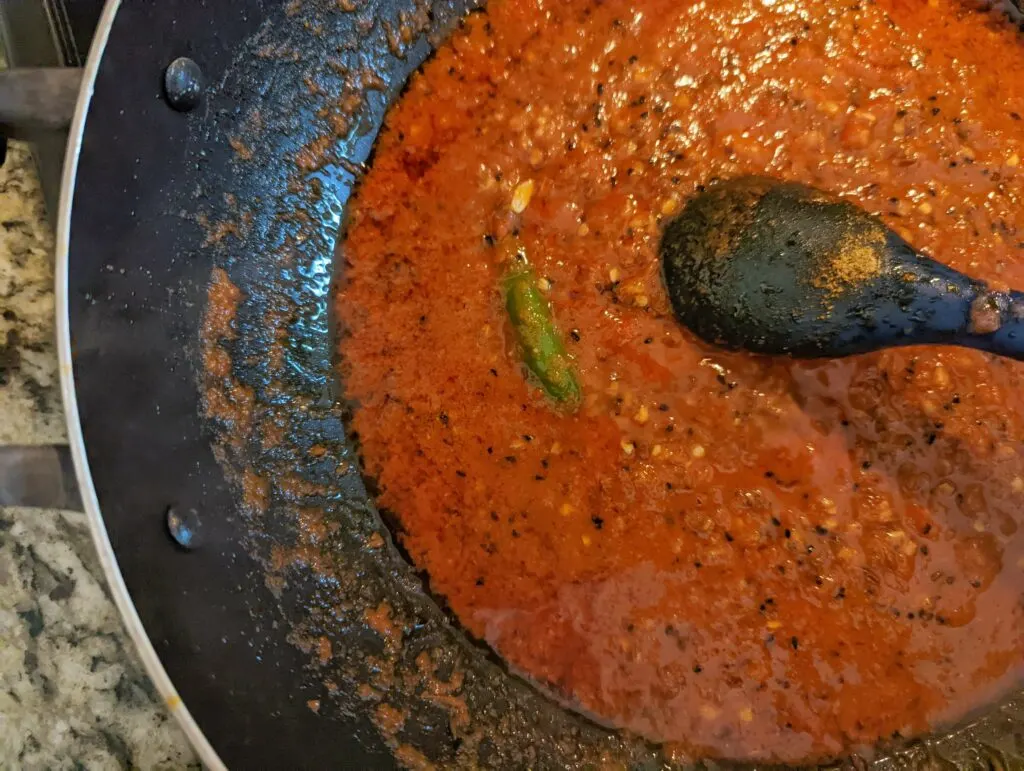
Step 6: Remove the goat from the Instant Pot or pressure cooker and add it to the reserved tomato masala, along with the cilantro.
If the goat is not pull-apart tender, simmer until it reaches the desired tenderness. If the goat is tender, simmer for 10-15 minutes until it combines with the masala.
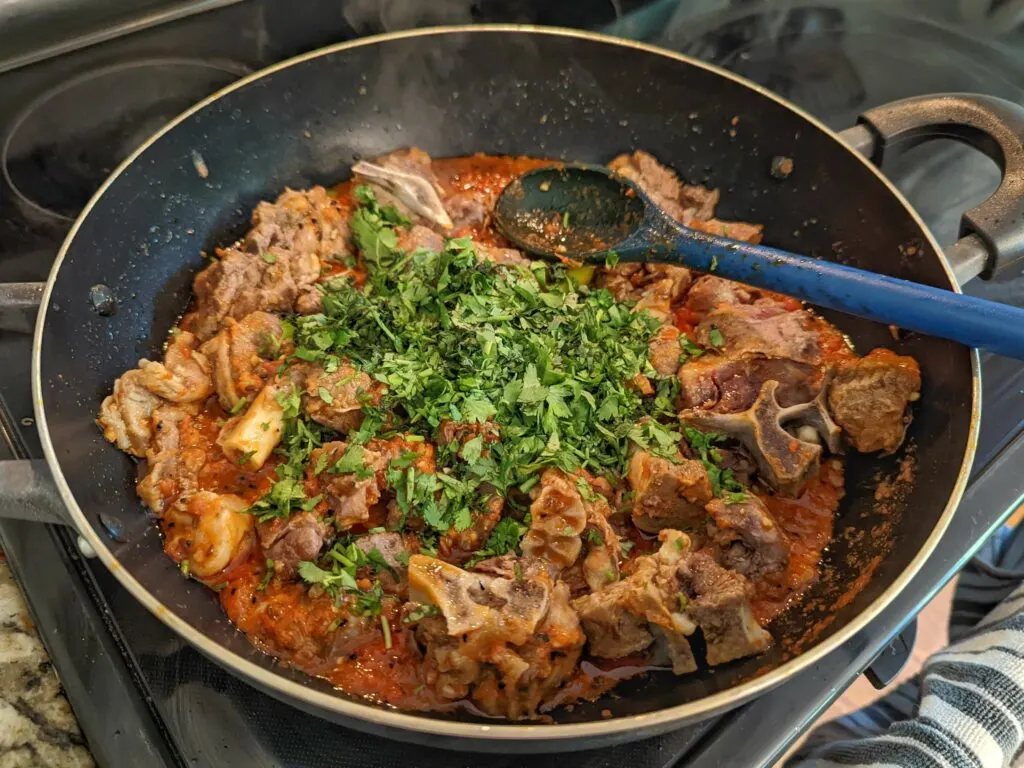
Step 7: Garnish with fresh ginger and cilantro, and serve with naan or basmati rice.
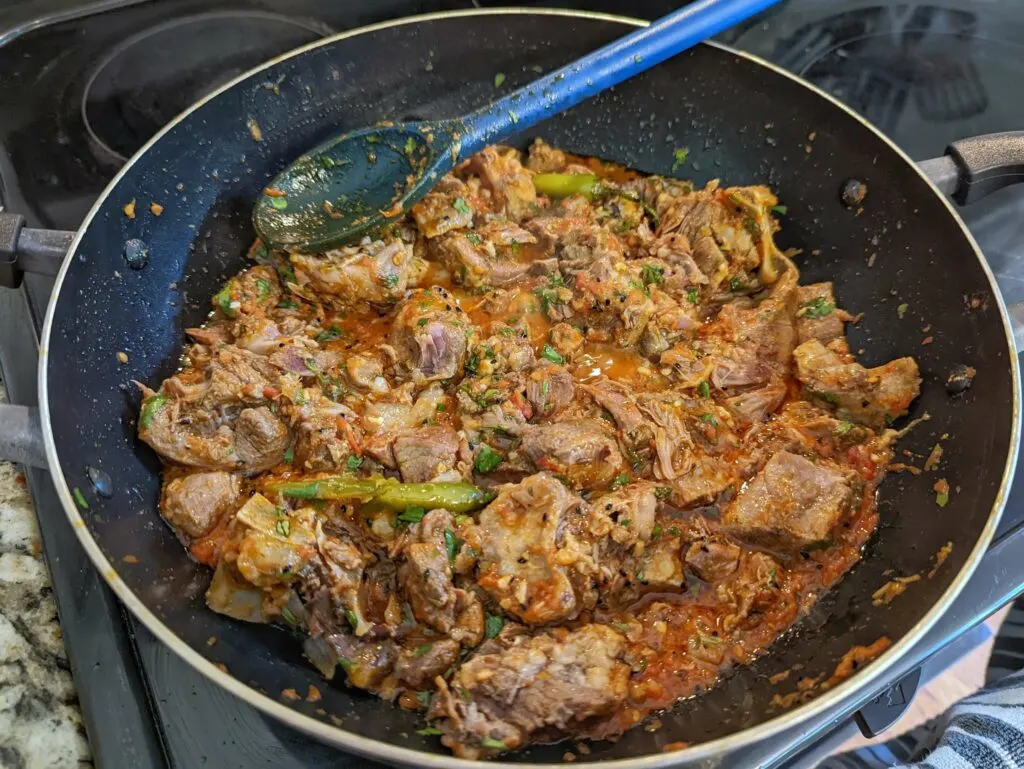
Can I Make Goat Karahi on the Stovetop?
If you’re short on time, you can use a pressure cooker to speed up the process of tenderizing the goat before adding it to the masala. However, if you prefer the traditional method, you can still make our karahi recipe by quick-frying the goat and reducing the heat for a slow braise.
- Warm 1/4 cup of the ghee in a heavy-bottomed pan over medium-low heat. Add cumin seeds and green chilies.
- Increase the heat to medium-high, add more ghee, and stir in the goat; continue frying until the color changes.
- Stir in the ginger and garlic, and cook for about 2 minutes.
- Next, Add salt, pepper, Kashmiri chili powder, cumin powder, coriander powder, and kalonji seeds to a small bowl. Stir the spices, cilantro, and pureed tomatoes into the pan. Lower the heat, cover, and gently simmer.
- Cook for one hour; stir it frequently to ensure nothing sticks to the bottom of the pan. Check the goat for tenderness at the one-hour mark by attempting to separate the meat from the bone using a fork. It should easily pull apart; if not, simmer until the goat reaches the desired tenderness.
- Garnish with fresh ginger, cilantro, and green chilies.
Expert Tips
- Similar to bhuna gosht, karahi involves a cooking technique called bhuna, or cooking over high heat until the ghee or oil separates. However, this technique may not be effective for goat or lamb, as these meats require longer cooking times to become tender. To overcome this, I recommend pressure-cooking the goat first, followed by a low-heat braise to help the ingredients meld together. If you don’t have an Instant Pot or pressure cooker, don’t worry – I’ve also included stovetop instructions for slow-cooking bone-in lamb or mutton.
- Remove the goat from the Instant Pot or pressure cooker and check for tenderness by attempting to separate the meat from the bone with a fork. If it’s not tender enough, continue simmering until it reaches the desired tenderness. If it’s tender, simmer for an additional 10-15 minutes to allow it to combine with the masala.
- While fresh tomatoes, garlic, and ginger aren’t absolutely necessary, using them will enhance the flavors and produce the best results.
- Avoid overcrowding the pan with goat or lamb because the moisture won’t evaporate. If you end up with too much liquid in the pan (tell me how I know this), remove the meat and set it aside; this allows the masala to cook down faster. Return the goat once it reduces.
- To prevent excess moisture from accumulating in the pan, it’s important not to overcrowd it with goat or lamb. In case you end up with too much liquid, remove the meat and set it aside to allow the masala to cook down faster. Once it reduces, return the goat to the pan and continue cooking.
Searching for More Like This?
If you love this recipe, try one of these Indian favorites!
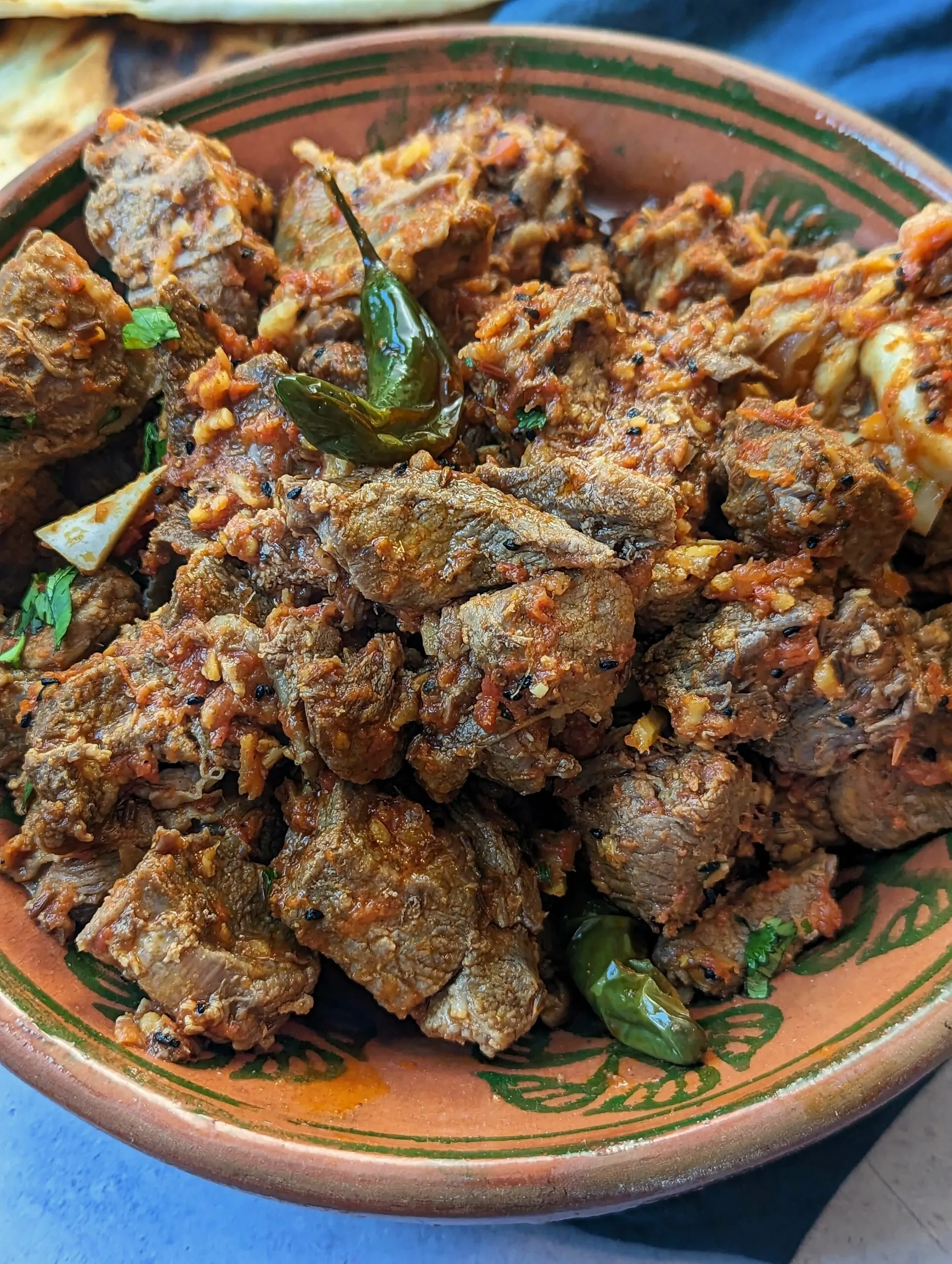
Serving Suggestions
- Rice: Basmati Rice, Jeera Rice, Pulao, Cauliflower Rice
- Bread: Naan, Chapati, Roti
- Salad: Chickpea Salad, Avocado Cucumber Tomato Salad, Kachumber Salad
- Sauce: Easy Raita, Chutney
- Dessert: Indian Mango Lassi
What to do With the Leftovers
- Refrigerate – Store the leftovers in an airtight container for 3-4 days.
- Freeze – Let the dish cool and transfer it to a freezer-safe container or bag for storage. Karahi gosht freezes for up to 2-3 months.
- Thaw – Defrost the meat in the refrigerator overnight.
- Reheat – Leftover karahi is even more delicious since the ingredients have had the chance to come together. Warm them on the stovetop and prepare your sides.
Frequently Asked Questions
What is gosht?
Gosht is a Persian word for meat; in India and Pakistan, the term gosht most often refers to goat or lamb. Gosht is a popular ingredient in many South Asian dishes, including curries, stews, biryanis, kabobs, paya, and comfort meals like mutton soup.
What is karahi curry made of?
Curry is a Western term given to South Asian dishes that contain gravy, so by that definition, it’s a curry. However, many would agree that karahi is a separate and stand-alone meal. I’m not exaggerating when I say karahi tastes like heaven, even without the yogurt, cream, or cashews that other curries feature.
Why is it called karahi?
Karahi or ‘kadai’ derives its name from the wok-like pan it cooks in. While the dish gets its name from the pan, karahi is better known for bite-size cuts of lamb or goat simmering in a richly spiced tomato gravy.
If you don’t have access to a karahi, there’s no need to worry. Feel free to use a wok or a heavy-bottomed pan like a saute pan, Dutch oven or a wok.
How do I make sure the gosht is tender?
Unlike chicken karahi, which cooks relatively quickly, lamb and goat require a longer cooking time to become tender. To ensure the meat is fork-tender it’s best to pressure-cook the meat first followed by a slow braise.
Can I make karahi gosht spicy?
Although our goat karahi recipe may look spicy at first glance, it’s actually quite mild. However, it boasts intense flavors from traditional Indian spices.
If you prefer a spicier dish, you can chop the chilies before adding them or increase the amount of Kashmiri chili powder.
More Indian Recipes:
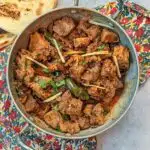
Karahi Gosht
- Heavy-Bottomed Pan , Wok, or Karahi
- 1 ½ pounds lamb or mutton shoulder bone-in, cut into 1-inch pieces
- 2 teaspoons kosher salt
- 1 cup water
- 3-4 tablespoons ghee
- 2 teaspoons cumin seeds
- 2-3 green chilies
- 1 – inch fresh ginger, finely grated
- 4 cloves garlic, finely minced
- 2 teaspoons kosher salt
- 1 teaspoon Kashmiri chili powder
- 1 teaspoon coriander powder
- 1 teaspoon kalonji seeds
- ½ teaspoon black pepper, coarse ground
- ½ teaspoon ground cumin
- 4 Roma tomatoes, pureed
- ¼ cup cilantro, chopped
- 2 – inch fresh ginger, julienne, for garnish
- ¾ cup cilantro chopped, for garnish
- Add lamb or mutton, water, and salt to an Instant Pot or Pressure Cooker. Cook at manual high pressure for 30 minutes if you’re at low elevation and 1 hour for those at a higher elevation.
- Meanwhile, warm the ghee in a heavy-bottomed pan over medium-high heat. Then, add cumin seeds and green chilies. Cook until they sputter.
- Add ginger and garlic, and cook for another couple of minutes until the raw smell fades.
- Stir the salt, pepper, Kashmiri chili powder, ground cumin, coriander powder, kalonji seeds, and pureed tomatoes into the mixture.
- Lower the heat, cover, and simmer for 15 minutes; stir to ensure nothing sticks to the bottom. Then, remove from heat until the goat finishes cooking.
- Remove the goat from the Instant Pot or pressure cooker and add it to the reserved tomato masala, along with the cilantro. If the goat is not pull-apart tender, simmer until it reaches the desired tenderness. If the goat is tender, simmer for 10-15 minutes until it combines with the masala.
- Garnish with fresh ginger and cilantro, and serve with naan or basmati rice.
- Similar to our Bhuna Gosht, karahi also involves a cooking technique called bhuna, or cooking over high heat until the ghee or oil separates. However, this technique may not be effective for goat or lamb, as these meats require longer cooking times to become tender. To overcome this, I recommend pressure-cooking the goat first, followed by a low-heat braise to help the ingredients meld together. If you don’t have an Instant Pot or pressure cooker, don’t worry – I’ve also included stovetop instructions for slow-cooking bone-in lamb or mutton.
- Remove the goat from the Instant Pot or pressure cooker and check for tenderness by attempting to separate the meat from the bone with a fork. If it’s not tender enough, continue simmering until it reaches the desired tenderness. If it’s tender, simmer for an additional 10-15 minutes to allow it to combine with the masala.
- While fresh tomatoes, garlic, and ginger aren’t absolutely necessary, using them will enhance the flavors and produce the best results.
- Avoid overcrowding the pan with goat or lamb because the moisture won’t evaporate. If you end up with too much liquid in the pan (tell me how I know this), remove the meat and set it aside; this allows the masala to cook down faster. Return the goat once it reduces.
- To prevent excess moisture from accumulating in the pan, it’s important not to overcrowd it with goat or lamb. In case you end up with too much liquid, remove the meat and set it aside to allow the masala to cook down faster. Once it reduces, return the goat to the pan and continue cooking.
- The nutritional information shown is an estimate provided by an online nutrition calculator. It should not be considered a substitute for professional advice.

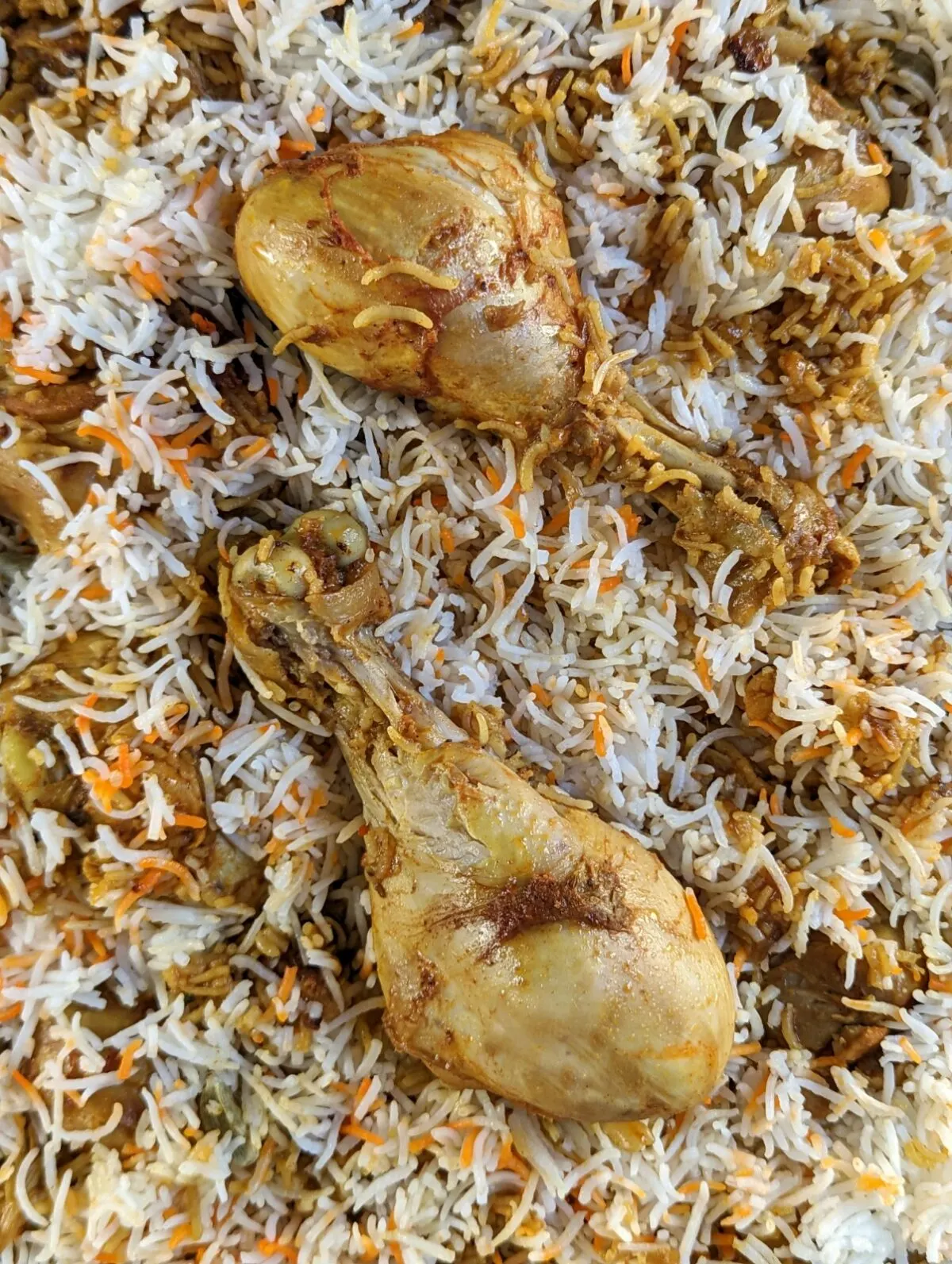
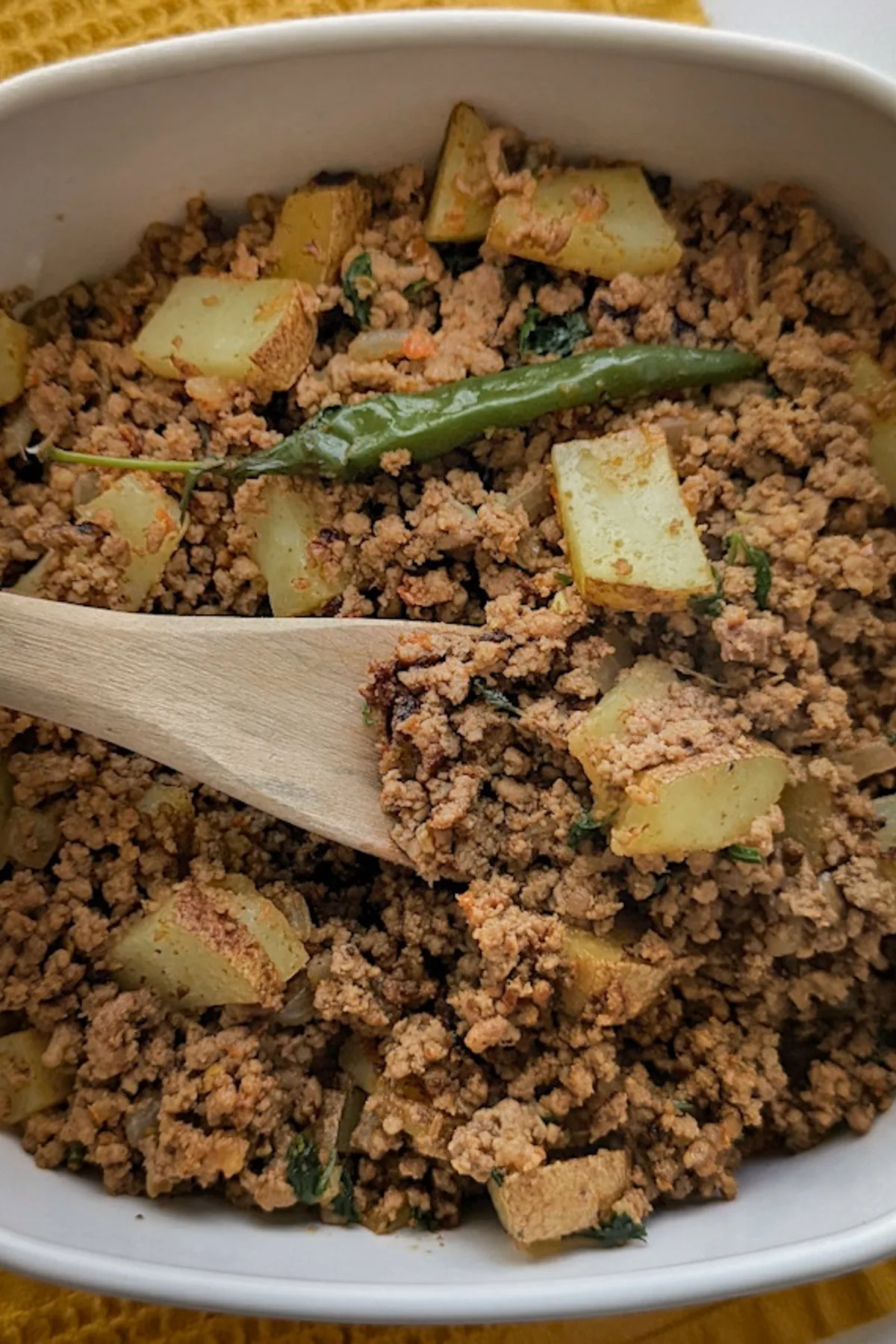
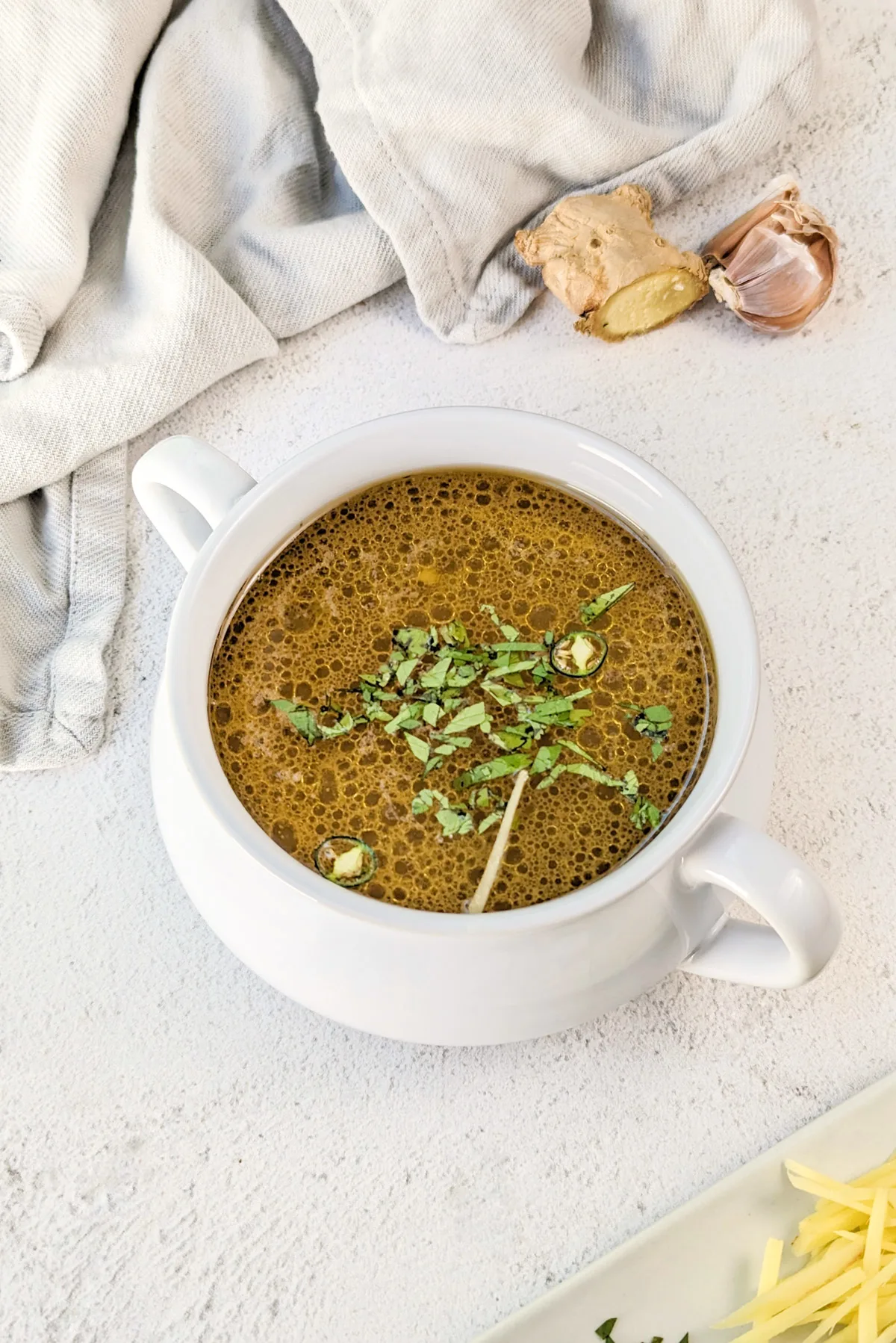
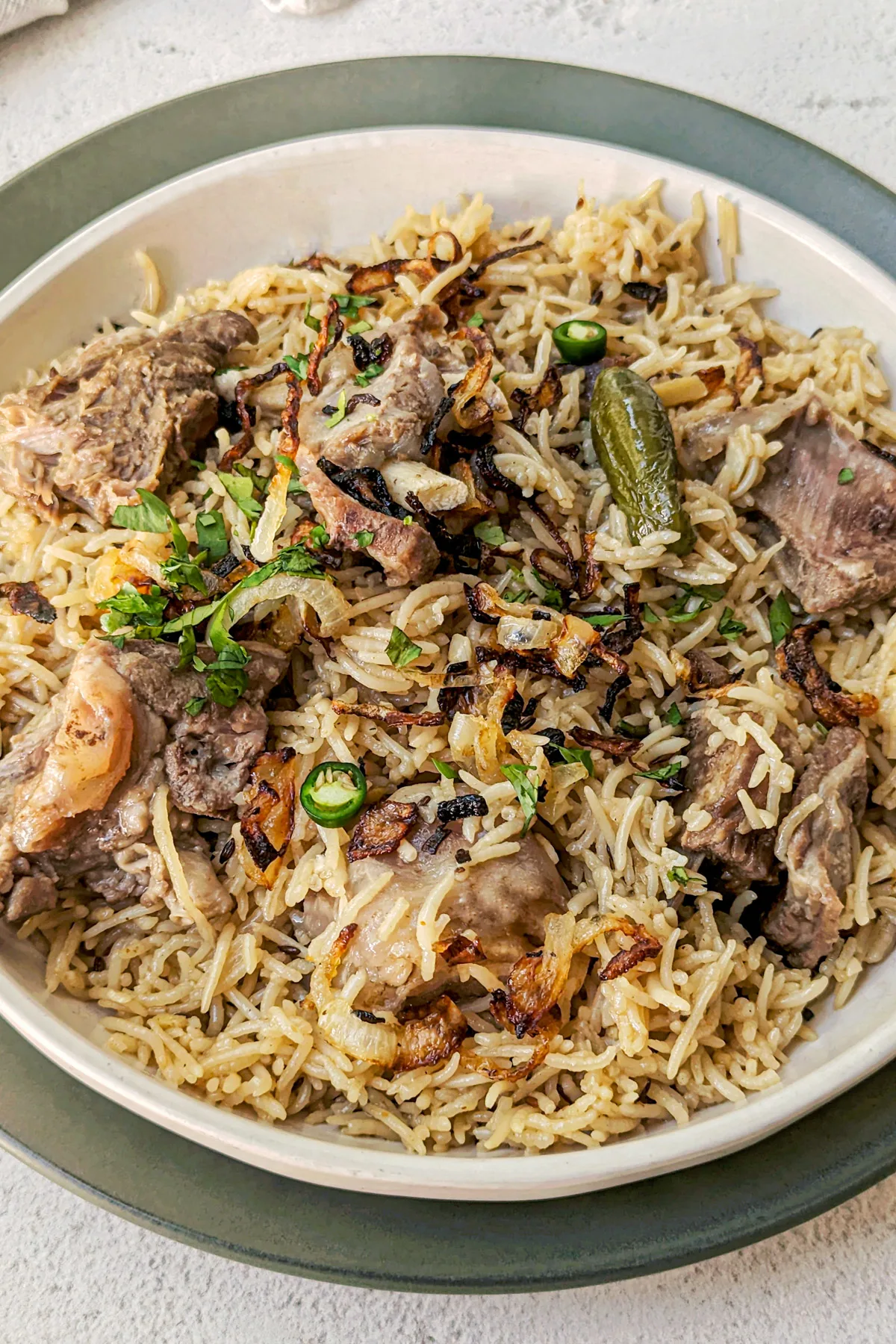
Ravi Patel
Friday 26th of May 2023
Great curry!
Emily Thompson
Friday 26th of May 2023
Oh my goodness, this Karahi Gosht recipe is an absolute delight! The flavors are incredibly rich and the tomato-based curry is bursting with freshness. The combination of fresh ginger, garlic, and green chilies adds a fantastic kick to the dish. I appreciate that this recipe stays true to the traditional roots of Pakistani cuisine by focusing on the basics. It's evident that the flavors have been carefully balanced, resulting in a truly authentic and satisfying dish. I can't wait to make it again and impress my friends and family with this delicious taste of Pakistan!
Sarah J.
Thursday 16th of February 2023
I made the Karahi Gosht recipe last night, and it was incredible! The flavors were so bold and authentic, and it was surprisingly easy to make. I'll definitely be adding this to my regular rotation of dinner recipes.
Bianca
Saturday 16th of July 2022
I was so excited to try this recipe! Pakistani curry sounded so good and it absolutely did not disappoint! It was so delicious
Tressa Jamil
Saturday 16th of July 2022
It's one of our favorites and always hits the spot!
Fede
Thursday 14th of July 2022
I made this few times and was incredibly good.
Tressa Jamil
Thursday 14th of July 2022
I love hearing that it's become a regular part of your rotation.